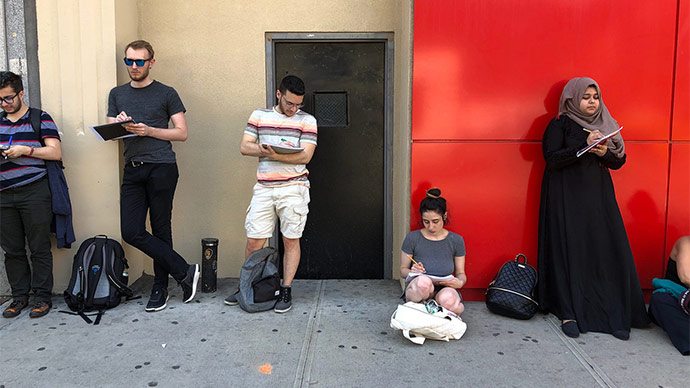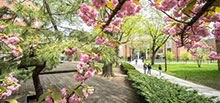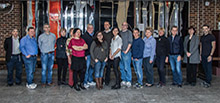New Field School Transforms Manhattan’s Lower East Side into a Classroom
Aug. 28, 2018
and Audrey M. Peterson
Students from the urban anthropology project field school map a block—sketching and recording details of every building, structure, and significant detail—on the Bowery in Lower Manhattan. The maps are part of the field journals the students maintain throughout the course.
It’s mid-June and a lively discussion is in progress among Brooklyn College undergraduate students in a sunny conference room at CUNY’s Center for Worker Education at 25 Broadway. The room has been given over to an urban anthropological field school. The subject is gated communities—walled and guarded—and their effects on an increasingly polarized American public. But instead of suburban enclaves far outside of New York City limits, the students are talking about recently gated co-ops on Manhattan’s Lower East Side.
After an hour’s talk dissecting the concepts of urban fear, security, class division, and gentrification, the class, with anthropology professors Naomi Schiller and Kelly Britt, walk more than two miles to the Masaryk Towers. A subsidized middle-income housing complex, the towers had new gates installed, cutting off a shortcut through the complex that until very recently was open to the public, particularly the residents of the Baruch and Gompers Houses across the street. The classroom discussion is now playing out in living color, as a guard barks at the students for proof that they have legal access to the property. “It’s okay, I live here,” says one of the students flashing her ID. “These people are my guests.”

Professor Naomi Schiller, left, and Professor Kelly Britt, third from right, with students from the Lower East Side Urban Anthropology fields school, June 2018.

Professor Kelly Britt examines clay pipe fragments at the Lower East Side Tenement Museum with students from the Urban Anthropology field school.

Students catalog artifacts from the Lower East Side Tenement Museum, a landmark building whose apartments were recreated to chronicle the lives of immigrants in New York City in the 19th and 20th centuries. The assignment was to create 'artifact biographies,' about the history and everyday use of these objects.

Students make careful note of the numerous permits and other notices posted at 85 Bowery in Chinatown. The building became the focus of media attention when the rent-regulated tenants, who contend that city agencies have failed to protect them from 'construction harassment,' went on a hunger strike in January 2018.

Students examine how the East River meets the shore.

Bob Humber, left, a founder and caretaker of the M'Finda Kalunga Community Garden, situated on the Lower East Side in Sara D. Roosevelt Park, speaks with Professor Schiller and students.

Since its founding in 1982, the nearly block-long garden has grown into a full-scale community gathering space, hosting celebrations such as the Chinese Moon Festival, Juneteenth, Cinco de Mayo, and Sukkot, gardening workshops, and live music and poetry readings.

On a walking tour in the Lower East Side, a guide from the Lower East Side Tenement Museum displays a map of the Seward Park Coops, built in 1959–60, on Grand and Norfolk Streets. In 2017, the residents of these buildings, which were privatized in the 1990s, rejected a developer’s offer to purchase air rights, fearful that the construction of tall buildings on either side of the development would box it in and block light.

Students visit the firm of Matthew Nielsen Landscape Architects to learn about the project to build coastal protection for the Lower East Side, known as the East Side Coastal Resiliency project, from its designers Molly Bourne, Principal at Mathews Nielsen, and Margaret Hopkins, Technical Director at the engineering firm AKRF, INC.

Students observe a press conference held in opposition to the construction of mega-towers on the East River waterfront of the Two Bridges neighborhood. Long-term and low-income residents fear they will be priced out as the neighborhood, located between Brooklyn and Manhattan Bridge and encompasses the Lower East Side and Chinatown, becomes increasingly gentrified.

Students attend a Full Board meeting of Community Board No. 3, which covers the Lower East Side and part of Chinatown. Students take notes, make observations, and become acquainted with community members, their concerns and desires for the neighborhood.

On a walking tour of the Lower East Side, Professor Schiller pauses under the Williamsburg Bridge to discuss the way the built environment shapes social relations in the community, including the recent gates that the Mitchell-Lama Masaryk housing campus (in the background) put around its perimeter.

Students meet with a staff member from GOLES (Good Old Lower East Side), a housing advocacy organization that works to build resiliency in the Lower East Side.
For Schiller and Britt, the summer course called The Urban Anthropology Project is a bit of an experiment. To begin, this type of cultural anthropology and archaeology field school—an immersion in the Lower East Side—has never been taught at Brooklyn College. “The neighborhood is in the midst of a major new wave of gentrification and waterfront development,” says Schiller. “We’re asking the students to explore how class, race, gender, and migration status intersect to shape the ways that residents approach the contemporary threat of extreme weather and rising seas. But we’re starting way back—before European settlement—to think about land use, social relationships, and the changing built environment over time”
The class is also unique in that Schiller and Britt have teamed up to combine their subfields, cultural anthropology and archaeology.
Walking tours are just one of the ways Britt and Schiller are helping their students explore the history and contemporary struggle for space and survival on the Lower East Side. The professors also scheduled films, museum visits, trips to observe community board meetings, visits from experts, interviews with local residents, and archaeological artifact analysis.
“What’s different is that we’re teaching archaeological and ethnographic methods in the same course. That’s not been done here before,” says Britt. “We’re helping students develop essential skills such as recording field notes and interviewing as they study resiliency, gentrification, urban planning, community organizing, sea-level rise, and climate change.”
“And we’re co-teaching,” Schiller and Britt say almost together. “We volunteered to split the salary between us because we wanted to teach this new course and learn from each other,” says Schiller. “We are aiming to give future anthropologists the tools to approach the field in a more ethical, holistic manner than traditionally taught in many anthropology departments.
The courses of the Department of Anthropology and Archaeology present the richness in human variation and cultural diversity, and offer the anthropological perspective as a way of thinking, a way of problem solving, and as a model for future learning. Field schools usually occur during the summer sessions or the winter intersession. To learn more, visit the Department of Anthropology and Archaeology.






